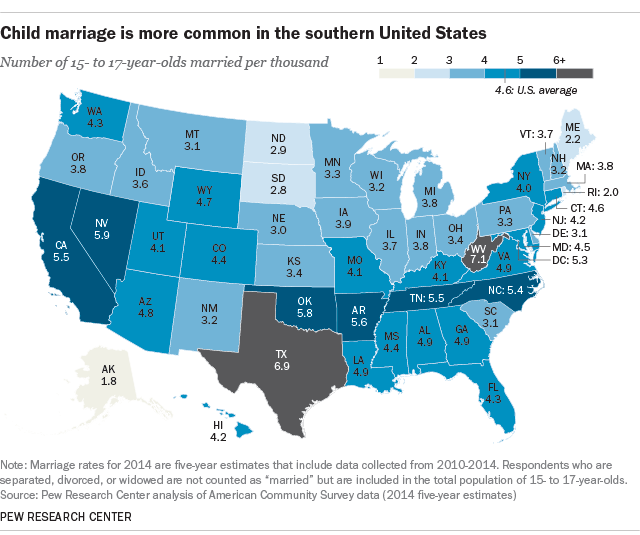While you might think that child marriage only occurs in developing countries, a study published today proves that’s just not the case.
As many as 57,800 children between the ages of 15 and 17 are married in the US, according to findings by the Pew Research Center.
That’s a population roughly the size of Texas A&M University’s student body.
Numbers vary by state, with West Virginia and Texas having the highest proportion of child marriages (7.1 and 6.9 child marriages per 1,000 people) and Alaska and Maine the lowest (1.8 and 2.2 child marriages per 1,000 people).
So how does this happen in a country where citizens must legally be 18 to marry?
The answer is in the fine print. While 18 is defined as the legal age for marriage in the United States, children as young as 12 or 13 can get married if a judge rules it’s in their “best interest.” (Some states, like Arizona and Missouri, have no minimum age for judicially approved marriages in special circumstances like a pregnancy or birth of a child.) In most states, 15- to 17-year-olds can be married with parental approval.
Read more: Evidence Shows Education Can Help Reduce Child Marriage
Generally, the study — which was from the Census Bureau’s American Community Survey — found that women are more likely than men to marry at an early age. 55% of married children aged 15 to 17 are women; that number jumps to 66% for 18 to 19 year olds.
Compared to many developing countries, child marriage rates in the US are miniscule. In Niger, roughly 3 in 4 women are married before the age of 18. On average, in developing countries one in three women are married before they become legal adults, according to World Vision.
The non-profit Girls Not Brides estimates that by 2050 there will be 1.2 billion child brides worldwide. Today, 700 million women around the world were married before the age of 18.
Read more: These Are the Best and Worst Countries For Girls Around the World
Child marriage is often a result of poverty and a lack of schooling. It’s proven that child marriage furthers the cycle of poverty, as women who are married before the age of 18 are more likely to contract HIV, experience domestic violence, and fall into depression, and less likely to receive an education or become employed.
The US has the resources and the ability to bring the number of child brides and grooms down to zero, but it will require a change of policy on a state-by-state level and not necessarily on a national level. Let’s hope these most recent statistics will spark state legislators to take action.
